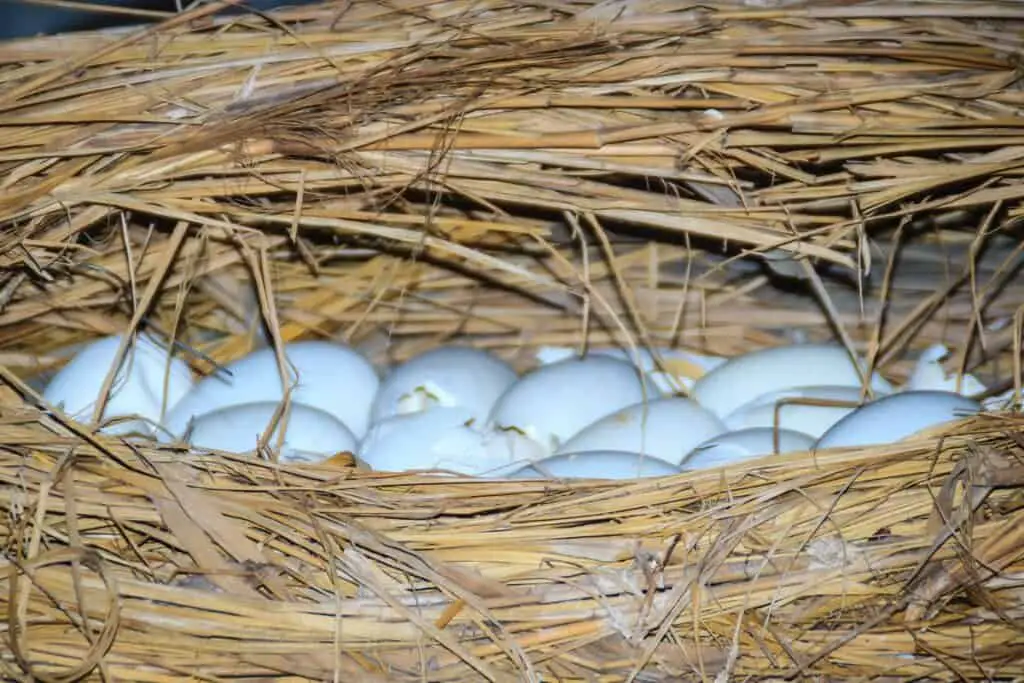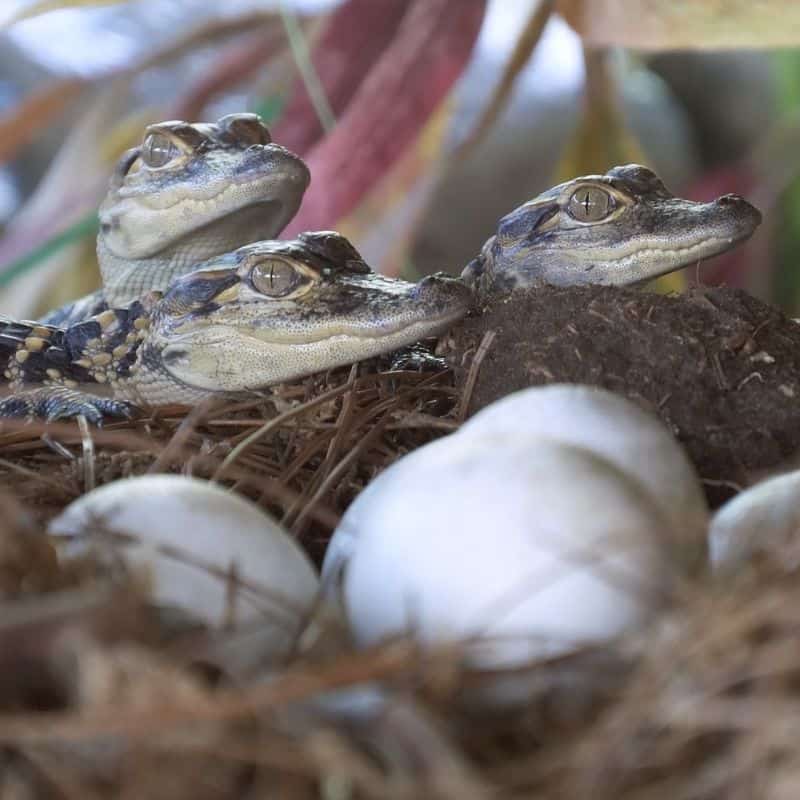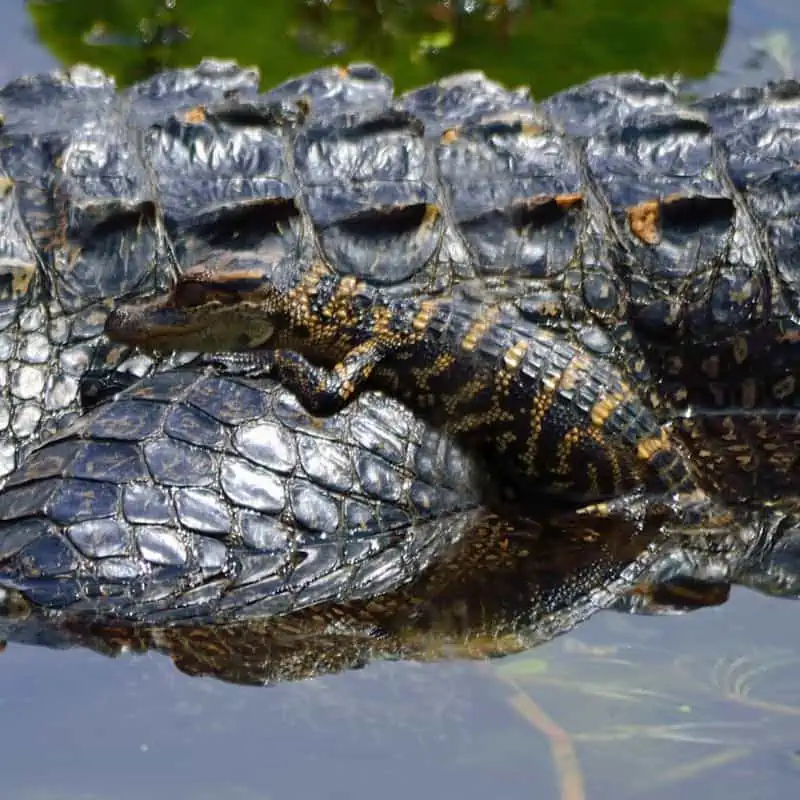Alligators have been around for millions of years and are native to Mexico, the United States, and China. These reptiles are amazing creatures, but how do they reproduce, and do alligators lay eggs?
Alligator females lay between 20 to 50 eggs. The egg weighs 3 ounces; it is oval in shape and white and translucent in color. The outer layer is hard, and the inner is soft like leather. As the embryo grows, the outer layer becomes thinner until it is soft enough for the hatchling to free itself.
Let’s delve into more detail about alligator eggs, how the embryo develops inside the egg, and alligator ranching programs and egg incubation.

Alligators Do Lay Eggs
When the male and female alligator is about 6 feet long, which they attain at an average age of 10 to 12 years, mating will take place. The male will circle the female and then mount her for copulation.
When this happens, the eggs are internally fertilized. Mating will usually occur in May, and the female will then build her nest and lay her eggs in late June or early July.
A mother alligator will lay between 20 to 50 eggs in her nest. These eggs weigh about 3 ounces, slightly heavier than a duck egg or a large chicken egg. An alligator’s nest comprises of sticks, mud, and other plant material.
These nests will be about 6 feet wide and 3 feet high.
A female alligator will usually make her nest along the banks of marshes and ponds. The mother will cover her newly laid eggs with vegetation to incubate them.
It will take about two months before the eggs hatch.
What Does An Alligator Egg Look Like?
The egg of an alligator is oval, white, and translucent. An alligator egg is at first hard, like a chicken egg.
The outer layer is hard, but the inner layer is soft and feels like leather. As the alligator grows inside the egg, the outer layer becomes thinner.
When the hatchling emerges from the egg, the outer layer is so thin that it is much more fragile than when they were laid.
The baby alligator has a tiny spike called an egg tooth at the end of its nose that it uses to free itself from the egg. After a few weeks, this tiny tooth disappears.

Alligator Nest Temperature Determines The Hatchlings’ Sex
The nest temperature will determine if the eggs develop into male or female alligator babies.
Temperatures of 82 to 86°F will produce females, and temperatures of 90 to 93°F will produce males.
If the temperature is between 82 and 90°F, the eggs will produce mixed genders.
The Alligator Mother
An alligator mother is fiercely protective of her eggs. Like crocodiles, she will guard her nest, watching for the slightest squeak and peep from the eggs to signal that her offspring is about to emerge.
When this happens, she will remove the vegetation covering the eggs.
The mother will carry them to the water as soon as the hatchlings emerge. Once in the water, she will carry them on her back. The babies will eat insects, crawfish, tadpoles, and small fish.

A mother alligator will stay with her hatchlings for the first year of their lives. She will continue to be close to them even when they become juveniles.
Young alligators will stay in a juvenile pod, a group of juveniles from different mothers, for at least three years.
The pod will protect them from predators such as large fish, birds of prey, and even other adult male alligators.
Alligator Eggs In The Wild
In the wild, about 1/3 of alligator nests are destroyed by predators such as raccoons or flooding.
Of an original batch of 38 eggs, only ten alligator hatchlings will live to one year, and only five will reach maturity.
The alligator eggs are susceptible to drowning, being crushed by the female, or being eaten by predators.
The young juvenile alligators are eaten by wading birds, larger fish, or adult alligators. Juvenile alligators are the largest known reptile to be able to regrow their tails, and this is one factor that helps with their survival in the wild.
Incubating Alligator Eggs
Alligator ranching programs were introduced in the U.S around the 1980s.
Legal alligator farms, under the Department of Wildlife and Fisheries, play their part in the survival of many new hatchlings.
The eggs are incubated, hatched, and then once the alligators reach 3 to 5 feet in length, they are released back into the wild.
Collecting Alligator Eggs
The alligator eggs are collected from nests in the wild. These nests are located by conducting aerial surveys using helicopters. The areas are marked, and then ground crews will travel by airboats to the marshes to collect the eggs from the nests.
Once the eggs are located, the eggs mustn’t be turned over, as this will detach the embryo from the egg membrane, causing the embryo to die.
The eggs are marked so they can be carefully transported in the exact way they were lying inside the nest so as not to disturb the embryo.
The eggs are also placed into the incubator in the same way with the marked side on top.
What Is The Preferred Age For Egg Collecting
Farmers prefer to collect eggs that are less than seven days old or to wait until they are more than four weeks old. During this 7-to-28-day period, the eggs are at their most fragile.
Farmers can tell the age of the egg by its appearance. Eggs that are newly laid have a slimy coating, and after 24 hours, the egg will have a chalky white dot at the top where the embryo has attached to the egg membrane.
The dot will form a band around the egg over the next few days and will get wider until both ends of the egg have this chalky white color, usually after 40 to 50 days.
This chalky color is the network of blood vessels that allows the embryo to exchange carbon dioxide and oxygen.
This band will also tell the farmer that the egg is fertile. During incubation, if this band does not grow, the embryo has not developed.
Infertile eggs will have a yellow glow when a light is held against them, whereas fertile eggs have a dark area in the middle with lighter spots on the end.
Alligator Egg Incubation
The alligator eggs are housed in containers with vegetation collected from the original nest. Some farmers prefer to use Sphagnum moss or water-soaked hay placed in boxes that have holes drilled on the sides for airflow.
At this stage, the humidity and temperature of the incubators must be monitored and controlled.
As in the wild, the temperature of the incubators will determine the sex of the hatchlings. Temperatures of 91°F will produce males and temperatures of 86°F the females. Farmers prefer to set their thermostats at 87 to 88°F, producing healthy alligators of both sexes.

Final Thoughts On Alligator Eggs
Alligator females lay between 20 to 50 eggs. The female alligator makes her nests along the banks of marshes and ponds, and the eggs take about two months to hatch.
The eggs are vulnerable, and about 1/3 of alligator nests are destroyed by raccoons or flooding.
To rescue the eggs, farmers collect the eggs from the nests, incubate them, and release some hatchlings back into the wild once they reach 3 to 5 feet in length.
